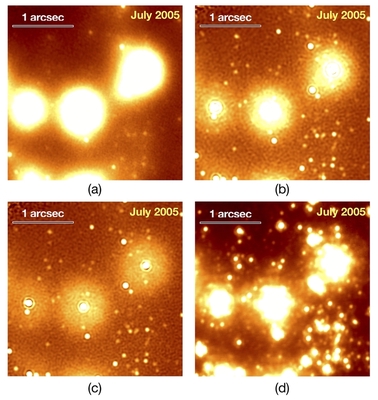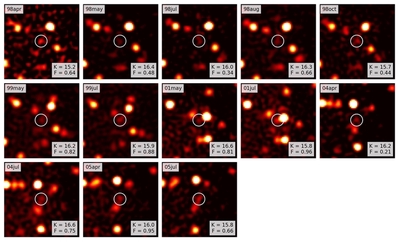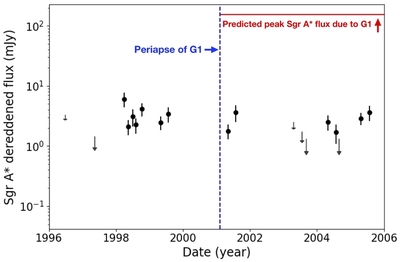Long-term gas feeding behavior of the central supermassive black hole
Publication: Consistency of the Infrared Variability of SGR A* over 22 yr
The Milky Way Galactic Center (GC), approximately 8 kpc from Earth, is host to the closest known supermassive black hole (SMBH). This makes it an excellent laboratory for studying the accretion properties of SMBHs. The accretion flow onto the SMBH at the GC gives rise to its radiative counterpart named Sgr A*. Sgr A* was initially detected in the near-infrared (NIR) with adaptive optics observations in 2002. While earlier data exists in form of speckle imaging (1995–2005) with shift-and-add technique, Sgr A* was not detected in the initial analysis. Here, we improved our speckle holography analysis techniques. This has improved the sensitivity of the resulting speckle images by up to a factor of three. See Figure 1.

With the new implemented speckle holography presented in this work, Sgr A* is now detectable in the majority of speckle epochs covering 7 yr (Figure 2). Here we report new infrared (IR) measurements of the supermassive black hole at the Galactic Center, Sgr A*, over a decade that was previously inaccessible at these wavelengths. This enables a variability study that addresses variability timescales that are 10 times longer than earlier published studies.

The brightness of Sgr A* in the speckle data has an average observed K magnitude of 16.0, which corresponds to a dereddened flux density of 3.4 mJy. Furthermore, the flat power spectral density of Sgr A* between ∼80 days and 7 yr shows its uncorrelation in time beyond the proposed single power-law break of ∼245 minutes. We report that the brightness and its variability is consistent over 22 yr. Finally, we note that the 2001 periapse of the extended, dusty object G1 had no apparent effect on the NIR emission from accretion flow onto Sgr A*. The result is consistent with G1 being a self-gravitating object rather than a disrupting gas cloud. See Figure 3.
